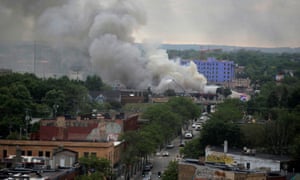Protests over killing of George Floyd highlight reality of tensions in the Twin Cities

Photograph: Carlos Barría/Reuters
It has been called the “Minnesota paradox”. The Twin Cities, comprising the conjoined urban areas of Minneapolis and St Paul, regularly tops the list of places in the US with the best quality of living.
Largely low rise and sprawling, set around the cities’ lakes and the Mississippi, the area is marked by affordable and largely good quality housing with lawns, parks, museums and tree-lined streets.
Its politics too have long reflected a strong progressive strand, represented by figures such as the late senator Paul Wellstone, once described as the most liberal member of the Senate. Employment – pre-pandemic, at least – was high, and St Paul serves as the global headquarters for 3M.
But there is another side to living in Minnesota, often ignored. Factor in the black and ethnic minority experience, and the state is suddenly not such a good place to live.
Despite Minneapolis celebrating itself as the city of Prince and Paisley Park, Minnesota’s black education and employment outcomes by US national standards have long been dismal in comparison with those of the state’s white population.
Rated in 2018 second in terms of overall best states in which to live in the US, in the same year Minnesota ranked close to the bottom for both employment gap by race (47th) and income gap by race (38th).
According to a report released last year, even before the mass unemployment triggered by the coronavirus took hold, some 10% of black American residents of the Twin Cities were unemployed compared with just under 4% of white American residents. Given the pandemic’s disproportionate impact on communities of color, that already bad situation has now worsened.
The reality of Minneapolis and St Paul is that behind the veneer of “Minnesota nice”, behind the reputation of a socially liberal and highly tolerant metropolitan area (in contrast with the state’s more conservative rural areas), there have long been glaring divisions along racial lines in a place where 20% of the population is African-American.
Despite having a white mayor, Jacob Frey, who has been outspoken about the problems of structural racism, and being located in the same congressional district that elected Ilhan Omar, the state’s first non-white woman to be elected to Congress, race relations have foundered on chronic inequalities and a series of high-profile killings of black people involving the 800-strong police force.
As the academic Samuel Myers, who coined the notion of the Minnesota paradox, pointed out two years ago, it is not only in employment and income gaps that the paradox exists, pointing to racial disparities in incarceration rates, in child maltreatment report rates, educational outcomes, and even racial disparities in drowning rates.
Among all these indicators, it is education that has witnessed one of the worst disparities, despite this being acknowledged as a problem by state officials and leading to a current restructuring effort to try to address the inequalities.
According to a report last year, while 95.9% of white adults in the Twin Cities metro area have a high school diploma, one of the highest figures in the US, just 82.2% of black adults do, a number below the national black high school attainment rate of 84.9%.
Add to all that the dangerous accelerant of the issue of police violence against black people, including the police shootings of Philando Castile in 2016 and Jamar Clark in 2015, which led to protests that shut down some of the city’s highways, and what occurred this week becomes more understandable.
Finally, as one resident pointed out to the Guardian, the impact of the coronavirus – not least its devastating economic impact on the poorest and least protected communities – has fed the simmering anger that existed before George Floyd’s killing.
All of which has left a journey along Minneapolis’s historic east-west thoroughfare Lake Street, location of the 3rd police precinct which was attacked after the Floyd killing, as a metaphor for many of the tensions.
A longtime magnet for new immigrants, from Scandinavians in the 19th century through black Americans during the Great Migration and those who relocated from cities such as Chicago in the 60s and 70s, to Hispanic, Hmong and most recently Somali immigrants, this street underlines the disparities.
Running from uptown with its wealthy homes, and bookended by the middle class neighborhoods close to the river where Black Lives Matter placards proliferated on lawns in 2016 after Castile’s killing, it also traverses poorer neighborhoods with immigrant-run businesses.
It was not always this way. While race relations in the state have largely mirrored the wider experience of the US, the Twin Cites in the 60s and 70s were seen for the African Americans who relocated there as a place with access to jobs and good schooling.
But race in Minnesota has become foregrounded even more in the Trump era, as some local rightwing politicians in towns such as Saint Cloud, outside the metropolitan area, have fostered anti-immigrant sentiment aimed largely at Somalis and Latinos.
All of which led Keeanga-Yamahtta Taylor to write in the New York Times that what is “unmistakable in the bitter protests in Minneapolis and around the country is the sense that the state is either complicit or incapable of effecting substantive change”.



